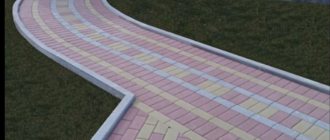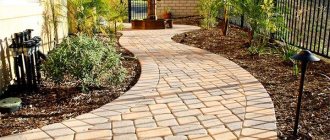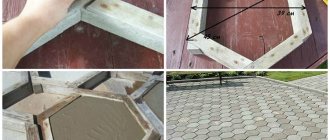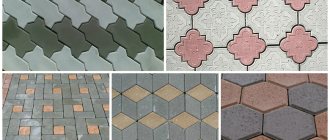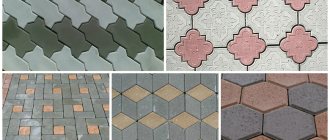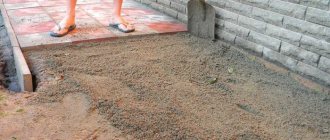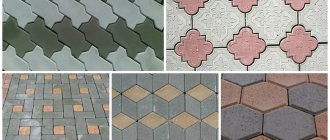Paving slabs and colors - production secrets
The technologies used in the production of tiles make it possible to obtain high-quality aesthetic material, but sometimes it needs to be transformed by changing the color. Today there are two methods of painting: through-painting and surface painting.
- Method 1 (through) is carried out by adding a special dye solution to the batch.
- Method 2 (surface) is applied to the finished product and allows you to change the color of the top layer.
Surface painting is carried out if it is necessary to change the colors of paving slabs on the laid material (to expand the palette) or to reduce slipping. For this purpose, alkyd or polyurethane dyes are used. The coating must be renewed periodically if the product is actively used. In order for paving slabs to retain their color longer (which is important), the paint for them is made from natural ingredients.
Through coloring is carried out using pigments, namely a fine powdery substance, which is obtained by carefully grinding natural components. Naturally, dyes obtained as a result of heat treatment of mineral raw materials can be added to the batch, i.e. artificial or metal pigments obtained from oxides or salts of metals and alloys. When you choose a powder for coloring, please note that the price of dyes varies, as a rule, it depends on the color and composition of the added component. Modern technologies make it possible to create a fairly diverse palette of paving slabs.
The colors of paving slabs can be varied by mixing coloring additives. But this process is feasible only with components that have the same dispersion. Usually two paints are combined, for example, when adding pigments of any other color to black, we get paving slabs in dark shades. Sometimes it is possible to mix powders of three tones. Moreover, it is unrealistic to accurately name the proportions of coloring components; the desired color and its shades can only be obtained experimentally.
Tip 4. Don’t use more than 3 – 4 colors
This advice follows from working with the color wheel - the schemes end with a combination of 4 colors. If there are more of them, the area will look too colorful and the harmony will be disrupted. In addition, when there are many colors, it is more difficult to choose successful combinations.
1539 rub. per sq. m.
Old City Choice 60 mm Leaf Fall Husky
Go to catalog
Two types of paving slabs were used in the paving: Old Town Husky color and brown rectangle with granite texture
Therefore, if you want to combine several colors in paving, consider what decor will be used in the future so that there are not too many shades.
The most durable colors of paving slabs
Today it is incredibly pleasing that it is possible to create your own original coating by choosing the color scheme of paving slabs from the variety offered by the market. Naturally, this is not done for one year, therefore, when purchasing tiles, it is important to pay attention to the pigments used in its manufacture. It is better if natural coloring components were used, for example, soot (black tiles) or a mixture of iron oxides (red). These substances almost do not lose color (do not fade) under sunlight. The undoubted advantage of these dyes is their natural origin and the possibility of repetition in other batches of products.
Paving slabs of brown color and others obtained by mixing red and black (brick and cherry colors) are considered quite practical to use.
The blue and green pigments suffer the most from natural factors. Their average lifespan is about one and a half years. Therefore, until quite recently, the former emerald path over time looks the same as the one on which gray paving slabs were laid. This feature must be taken into account when designing the site and choosing the color of the coating.
Light-colored tiles are quite durable, but not practical: yellow, orange, sand and lemon. Yellow paving slabs very quickly acquire a gray tint due to dust settling on them.
Tip 2. Use rich colors as accent colors
Tiles of bright colors, for example, red, green or orange, are not recommended for use as the main one, for several reasons:
- The site will look outdated.
Variegated paving has gone out of fashion. The trend is for coatings in calm natural shades. - The facade of the house will not stand out.
The tile will draw attention to itself, and the visual harmony will be disrupted. - Paving will get boring quickly.
If there is too much saturated color, then very soon it will begin to irritate.
Use bright tiles in edging, patterns, and paving individual areas, such as patios. Also, color accents can be textiles for garden furniture, pillows, flowers, flowerpots, benches and swings. It is important that they combine with each other, and the color wheel will help with this.
1482 rub. per sq. m.
Old Town Landhaus Braer 60 mm Pride
Go to catalog
1525 rub. per sq. m.
Old Town Weimar Braer 60 mm Mallow
Go to catalog
The edging is made of paving slabs in a more saturated Malva color. View project
What influences the choice of paving slab color
Gray paving slabs are the best solution if you are not aiming for an elegant design, but want to use the tiles only for practical purposes and save money on their purchase. Naturally, products not painted with expensive pigments cost much less. There are two ways to make gray paving slabs: vibration pressing and vibration casting.
When using vibration compaction, paving slabs are created in two colors: gray and red. Tiles made in this way can even be used in the construction of roads, because it is distinguished by its high strength.
Vibrocasting allows you to produce bright, light-colored tiles, since its basis is a concrete mass. The palette is usually represented by brown, yellow and red tones. Multi-colored tiles are more expensive than gray tiles due to the color pigments used. This type of coating is good for creating pedestrian paths.
When the dye is added to the cement-concrete mixture, paving slabs and paving stones are ideal because such material retains its appearance longer. But when only the top layer is painted, the colors of the paving slabs wear off quite quickly and lose their attractiveness.
How to choose the right paving slabs?
- Pay attention to the price - this is one of the leading, although not the only, criteria. The cost of the material depends on what pigments were used in production (foreign ones are more expensive).
- Purchasing paving slabs is not a case when you should give preference to a cheaper product. A paved path will look attractive longer and will not require repairs if it is made of high-quality material. Renewing or repairing tiles is not as simple as re-pasting wallpaper - it is a longer and more labor-intensive process. In addition, professional quality work is expensive and cannot be completed in a couple of days.
- When you are going to choose the color of paving slabs, it is advisable to pay attention to the decor and lighting features of the area. It is better if the tone of the coating is in harmony with the shades of the architectural details of your yard.
- When purchasing tiles, hold them in your hands and see how they look in the sun and in the shade. It is advisable to purchase material from one batch and with a reserve, otherwise the color of the tiles may differ.
- Gray paving slabs can harmonize with any shades and emphasize the advantages of the architectural style, so quite often when choosing a tone, gray is preferred. Another advantage of gray tiles is that if you need to purchase additional material, you are guaranteed a 100% color match.
Tip 3: Use a color wheel
There are several schemes by which you can select combinations on the color wheel:
Basic color combination schemes
Choose shades of the same color, but of different saturation. For example: you can buy light gray tiles and textiles to match a gray facade.
1482 rub. per sq. m.
Old Town Landhaus Braer 60mm Fog
Go to catalog
An example of a monochrome combination. View project
We already talked about this in the first section. But this way you can choose not only the color of the tiles, but also the shade of the decor and plants. For example, you selected orange tiles for a gray facade. In order not to disturb the combination, you can choose wooden furniture made of bright wood and buy pillows in different shades of gray.
An equilateral triangle fits into the center of the circle, and the colors that are at its corners are combined. For example, if you have a red house, then you can use tiles in blue shades for paving, and green pillows or garden furniture for decoration.
Combine three colors that are next to each other in the spectrum. For example, choose beige-brown tiles for a green facade, and lay out the patterns and edgings in purple.
1654 rub. per sq. m.
Mosaic Braer 60 mm Sandstone
Go to catalog
An example of an analog combination. View project
This is an additional contrasting combination, where, in addition to two opposite ones, another shade is used, usually adjacent to one of the first. For example, choose sand tiles for an orange house, and choose blue and turquoise flowerpots for decoration.
Two pairs of contrasting colors are used: red and green, blue and orange. For example, if the facade is made in red shades, then you can match it with orange tiles, and color accents can be made using blue and green garden decorations.
How colors are added to paving slabs during the creation process
Vibratory casting technology allows you to create the material for laying and choose the colors of paving slabs yourself, because for this there is no need to have any special equipment, unlike vibrocompression. The prepared mixture must be poured into plastic molds. It is advisable to have as many of these forms as possible, because the solution must stand for 2-3 days. Let's look at the stages of creation.
Stage 1. Preparing the form
Clean the inner surface of the mold from any remaining solution and cover with a thin layer of any lubricant (for example, used machine oil). You can apply the substance using a cloth or a brush, paying special attention to the corners, which are more convenient to lubricate with a brush. This will prevent the solution from sticking to the walls of the mold and deforming the final product.
Stage 2. Preparation of material for the solution
To make tiles from colored concrete, the mixture must include the following components:
- Water;
- Sand (large);
- Cement M500;
- Dye (pigment);
- Plasticizer (if possible).
Cement and sand should be in proportion 1:3 or 1:4. The amount of water is affected by the humidity of the sand. If you use a plasticizer, then for 1 kg of cement you will need about half a liter of liquid; if you work without it, then you need about one liter of water. More precisely can only be determined during the work process. The amount of plasticizer is determined in the instructions, and the pigment should be 3-5% of the weight of the cement.
Stage 3. Preparation of the solution
Pour sand and cement into a container intended for the mixture and mix thoroughly. It is better to use a concrete mixer or a construction mixer for this, but in the absence of such, you can “turn to” a shovel.
And now we come to the answer to the question: “How to make colored paving slabs?”
Pour water into a clean container, add dye and plasticizer (if any) and stir well. To ensure that the color of the paving slabs is uniform, under no circumstances should you pour the dye into the cement (you won’t get a harmonious distribution throughout the mixture). When the liquid has become uniformly colored, it must be poured into a mixture prepared from cement and sand. Mix everything very well.
It is important that the finished solution is not liquid. The mixture should be rigid, which is why a plasticizer is added.
Stage 4. Filling out the form
It is necessary that the finished solution be thick enough, and vibration is simply necessary during its placement in the molds. If there is no vibration table, your hands will help you. You need to shake the form, tap it or something on the table. When the surface of the solution is no longer covered with bubbles, the vibration process can be completed. The mixture should become smooth and even.
To prevent water evaporation, the finished forms are covered with cellophane. Hardened tiles can be removed from the molds after 2-3 days if they are kept at an air temperature of ≥20 °C. After this, the material should lie in the shade for about two more weeks, only then the paving slabs can be used for work.
Tip 5. Choose colors to match the style of the site
Paving should highlight the design of the garden. We talked about this in the article “Full review of BRAER tiles: collections, shapes, colors, installation options.” For example, if the garden is laid out in a landscape style, you should give preference to a material in brown tones like cobblestones or flat natural stone with a torn edge.
1399 rub. per sq. m.
Innsbruck Alt SteinRus 60 mm Beryl
Go to catalog
1399 rub. per sq. m.
Innsbruck Tyrol SteinRus 60 mm Beryl
Go to catalog
An example of paving curved paths on a site in a landscape style. View project
For a site in a regular style with a main brick building, it is better to choose rectangular tiles that will harmonize in color with the facade.
1595 rub. per sq. m.
Bavaria Steingot 60 mm Travertine
Go to catalog
An example of paving on a site in a regular style. View project
When the main building is a high-tech house made of concrete and glass, gray large-format tiles with a flat surface will be the ideal complement.
How to restore the color of paving slabs after laying them
The process of laying tiles is very exciting, because as the area of laid material increases, the appearance of the landscape and the entire estate changes. The color tone and texture of the product can transform an everyday atmosphere into a sophisticated one. Properly selected paving slabs will make the color of the house more expressive. Both the master tiler and the owner of the site can lay the tiles. But in any case, this process does not tolerate fuss and haste; the product must be placed carefully, correctly and without rushing anywhere. After laying the tiles, they must be cleaned immediately, because... This is, perhaps, the only possible option to give it its original appearance and beauty by cleaning it from putty and grout.
- First you need to remove debris and dirt using a vacuum cleaner or broom. Then prepare an aqueous solution for cleaning putty and treat the tiles with it, using a nylon brush. The instructions suggest different proportions of the ratio of water and mixture, however, to soften the solution, you can use the mixture itself, and then wash it with clean water. It is very important not to put off this procedure and carry it out no later than 10 days after installation. The later you clean, the more the solution thickens and, naturally, its removal becomes more difficult. Remember to change the water as it gets dirty to prevent dirt from returning to the tiles. The cleaning process must be based on a certain system. For example, when processing a large finished area, move according to the top-down principle, so that the cleaned tiles do not get smeared again, and the putty on the uncleaned ones becomes soaked.
- Soak the solution that has become very hardened on the paving slabs using a nylon sponge and a special cleaning agent, then remove the remaining solution with a silicone scraper (it can be purchased at stores that sell kitchen utensils, such as pots, bowls, pans, etc.). When all residues can be removed, rinse the cleaned area. Fill a clean bucket with distilled water and return to the place of work. There, treat the tiles with vinegar (5%), which is the best means for washing it, the most affordable and not capable of damaging the surface. After this, rinse thoroughly with distilled water to remove any vinegar stains. All you have to do is wipe with a clean towel, and the colors of the paving slabs will shine in all their glory.
- To treat the tiles and seams, you can use liquid sealant or putty to remove uneven surfaces and seal the seams. Please note that in most cases, concrete tiles may be porous but do not require a sealant. When working with this solution, use a disposable brush and don't forget a rag to immediately clean the surface on which it comes in contact.
How does coloring work to achieve the desired color of paving slabs?
You can paint the tiles using a water-insoluble pigment (powdered coloring matter). These dyes can be mineral and organic, and most experts recommend using alkyd and rubber paints and varnishes for painting paving slabs.
Rubber dye is a new word in paint and varnish production. However, it has already shown its advantages, which lie in the high quality of the painted material, which is not inferior to its production counterpart.
Rubber dyes have the following advantages:
- Fire resistance.
- The absence of odor typical of paints and varnishes, which distinguishes this dye from others.
- Wear resistance. Paints of this type are not afraid of either frost or heat. The colors of paving slabs do not change for quite a long time, despite exposure to ultraviolet rays, snow and other factors.
- Safety. Rubber dyes do not harm the human body and make the surface non-slip, which, you see, is important.
Alkyd dyes have the following advantages:
- Resistance to atmospheric factors and chemicals is perhaps their main advantage.
- Protecting tiles from rapid destruction. Thanks to this property, the coating can last longer.
A significant drawback is the pungent odor that persists for quite a long time after application.
Polyurethane dye, like the above-mentioned pigments, is highly resistant to external influences, including temperature changes. This dye is able to protect the tiles from rapid destruction. But it has one negative quality - this is a possible change in the color of paving slabs after some period of use of the coating.
Powdered pigments can be divided into three groups: metallic, chemical and natural.
- Metal pigments basically contain zinc and bronze alloys, from which powdered dye is obtained.
- Chemical pigments are created on the basis of synthetic substances as a result of certain chemical reactions. This is a fairly popular dye, because... has a number of advantages: wear resistance, dispersion, density and, importantly, low cost.
- Natural pigments are obtained by grinding and processing rocks. This is perhaps the most expensive dye.
The form of sale of powdered paints is a bag, and the price per unit of chemical pigment ranges from 65 to 120 rubles. Moreover, the price-determining factor is color: the red-orange color scheme is cheaper, and the blue-violet color is more expensive (100-110 rubles / kg).
The price difference is due to the specifics of creating these dyes. The red-orange palette of paving slabs is based on iron oxide, which has the same shade. This means that the manufacturer does not spend extra money to create paints of these colors. And to make dyes of green or blue tones, you need to add pigments that can give the desired shade. This entails additional costs (and considerable ones), which, of course, is reflected in the price of the product.
Bayer (Germany) and Omnikon (Denmark) are companies that are leading manufacturers of powder dyes. Bayer offers its products at a price of 80-430 rubles/kg, and Omnikon sells products for approximately 130 rubles/kg (and their range does not include green).
Please note that polyurethane and rubber paints are not much cheaper than powder paints. For example, a rubber dye made in Russia costs about 180 rubles/kg, and an alkyd dye costs from 50 rubles/kg (one of the cheapest).
To achieve maximum effect when creating certain colors of paving slabs, you must:
- Dissolve the powder (pigment) only in clean water.
- Calculate and measure proportions very accurately.
- Use clean tools and available materials (brushes, rollers, towels).
The colors of paving slabs can be applied after preliminary preparation, for which you need to do the following:
- 1st step. Clear the surface of debris, sweep or vacuum it. Even the smallest specks can negatively affect the coloring result.
- 2nd step. Spray the tiles with water and let them dry. To do this, you can use an ordinary garden hose or watering machine.
- 3rd step. Coloring. Only after the tiles have completely dried should you begin the painting procedure.
Rules for painting tiles:
- Familiarize yourself with the algorithm indicated on the paint package, because any dye has its own subtleties of application to the surface.
- Use a short-nap roller or brush to cover the color of the paving slabs.
- Before making the first layer of dye, add turpentine so that the paint sets faster.
- The second and subsequent layers are made with paint without adding turpentine. As a rule, a rich color is obtained after applying three layers of dye.
When working with paint, you need to mix it thoroughly so that the tiles turn out to be uniform. It will take several days to dry completely.
Paving slabs can combine two colors very harmoniously, and if you approach the process creatively, the result of your work will exceed all expectations. It is possible that an ordinary yard path will turn into a real work of art or become a highlight of the decor.
What colors of paving slabs do manufacturers offer?
It is quite natural that gray paving slabs lose out to colored ones. The price of the latter is not much higher than usual, and the finished product looks much more attractive. To paint tiles, inorganic powder dyes are used, which are evenly distributed throughout the product. Pigments may be produced by different manufacturers, but all dyes hold color quite well. This allows you to maintain the saturation of the palette for a long time, the paint will not fade or be erased. Therefore, you should not think that red or gray paving slabs are the “ultimate dream”. Rostovskaya can produce paving slabs of any color and degree of shade saturation, thereby satisfying the client’s wishes.
Granular single-color tiles are considered the most popular and inexpensive. It is based on quartz sand (grain size ≤ 2.5 mm or more), and the method of semi-dry vibrocompression is used in its production.
The facing surface consists of limestone grains, the diameter of which is about 2.6 mm. To make it as rough as possible, its front layer is washed with water from limestone milk and the stone is opened. This texture is very durable and practical, it is not slippery to move on, it protects the front layer from abrasion and exposure to natural phenomena. In addition, such paving slabs can be presented in any color shade. Below are the approximate colors of paving slabs in the photo:
The unique techniques that it uses involve mixing two or three dyes within one tile. In this case, the colors change, smoothly transitioning from one to another. The result is complex, unique patterns. Such tiles are very popular among consumers due to the freedom of color. Agree, it seems that paving slabs of two colors were laid, see photo below:
In addition, he uses three more techniques to obtain beautiful colors and bring the color closer to the color of natural stone. So, Landscape technologies:
Stone top
With this technology, marble/granite chips, processed by “washing,” are added to the front layer of the tile, which allows you to create a coating very similar to natural stone. The company offers a choice of grain sizes and colors. As a rule, the surface has the color of stone, but sometimes the colors of paving slabs are diversified by adding pigment and interesting color combinations are obtained.
Tiles made using this technology are an ideal solution for those who want to obtain a surface with the effect of natural stone at an affordable price.
Stone top "Crystal"
From time immemorial, crystals have been called “the game of nature”, because... they very subtly echo all sorts of shades of light and color. These natural masterpieces are born in the depths of rocks and can be white or colored, matte or transparent. But, whatever they are, the human eye rests, admiring the strange stones and marveling at its strength.
By collecting a collection of crystals or displaying part of it (as a “jewel highlight”) in your yard covering, you can make a lasting impression on others.
Macadam
When using this technology, the top layer is washed with water to remove cement laitance. This “washing” allows you to express the texture more clearly and make it grainy. Limestone grains with a diameter of 2.6-5 mm appear on the surface of the tile, which are mixed with natural crushed stone and minerals (quartz, granite, river pebbles).
The colors of paving slabs and their texture reflect the noble natural beauty of nature. Such a covering will emphasize the style and taste of the owner of the yard and will become a key design element.


